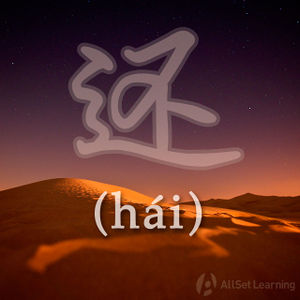Difference between revisions of "Expressing "and also" with "hai""
| Line 41: | Line 41: | ||
=== Books === | === Books === | ||
| − | * [[Integrated Chinese: Level 1, Part 1 (3rd ed)]] ( | + | * [[Integrated Chinese: Level 1, Part 1 (3rd ed)]] (p. 87) [http://www.amazon.com/gp/product/0887276385/ref=as_li_ss_tl?ie=UTF8&tag=allset-20&linkCode=as2&camp=217145&creative=399369&creativeASIN=0887276385 →buy] |
| − | * [[Modern Mandarin Chinese Grammar: A Practical Guide]] ( | + | * [[Modern Mandarin Chinese Grammar: A Practical Guide]] (p. 251) [http://www.amazon.com/gp/product/0415700108?ie=UTF8&tag=allset-20&linkCode=as2&camp=1789&creative=390957&creativeASIN=0415700108 →buy] |
| − | * [[Chinese Grammar - Broken down into 100 items - Basic and Intermediate Levels (汉语语法百项讲练 - 初中级)]] ( | + | * [[Chinese Grammar - Broken down into 100 items - Basic and Intermediate Levels (汉语语法百项讲练 - 初中级)]] (p. 198) [http://www.amazon.cn/gp/product/B004WA6JSQ/ref%3das_li_ss_tl?ie=UTF8&tag=allset-23&linkCode=as2&camp=536&creative=3132&creativeASIN=B004WA6JSQ →buy] |
*[[40 Lessons for Basic Chinese Course (基础汉语40课上册)]] (p. 73)[http://www.amazon.com/gp/product/B001FTL8D8/ref=as_li_ss_tl?ie=UTF8&camp=1789&creative=390957&creativeASIN=B001FTL8D8&linkCode=as2&tag=allset-20 →buy] | *[[40 Lessons for Basic Chinese Course (基础汉语40课上册)]] (p. 73)[http://www.amazon.com/gp/product/B001FTL8D8/ref=as_li_ss_tl?ie=UTF8&camp=1789&creative=390957&creativeASIN=B001FTL8D8&linkCode=as2&tag=allset-20 →buy] | ||
Revision as of 08:25, 20 March 2014
-
Level
-
Similar to
-
Used for
-
Keywords
Linking different actions with 还 takes no time at all to master.
Structure
The adverb 还 (hái) can be used to link two phrases together, in a similar way to "and also" in English. In this case, 还 begins a new phrase or clause.
Subject + Verb + Object 1, 还 + Verb + Object 2
Examples
- 我 有 iPhone, 还 有 iPad。I have an iPhone, I also have an iPad.
- 我 会 中文,还 会 英文。I can speak Chinese, I can also speak English.
- 我 想 吃 冰淇淋,还 想 吃 巧克力。I want to eat ice cream, I also want to eat chocolate.
- 我 要 一 杯 咖啡, 还 要 一 个 蛋糕。I want a cup of coffee, I also want cake.
- 他 是 我 的 爸爸,还 是 我 的 朋友。He is my father, he is also my friend.
- 妈妈 做 了 四 个 菜,还 做 了 一 个 汤。My mom made four dishes, she also made soup.
- 我 买 了 肉,还 买 了 菜。I bought meat, I also bought vegetables.
- 我 想 去 北京,还 想 去 成都。I want to go to Beijing, I also want to go to Chengdu.
- 我 喝 了 白酒,还 喝 了 啤酒。I drank wine, I also drank beer.
- 我 喜欢 吃 苹果,还 喜欢 吃 香蕉。I like apples, I also like bananas.
See also
- Continuation with "hai"
- "In addition" with "zaishuo"
- "In addition" as "lingwai"
- Expressing "in addition" with "haiyou"



